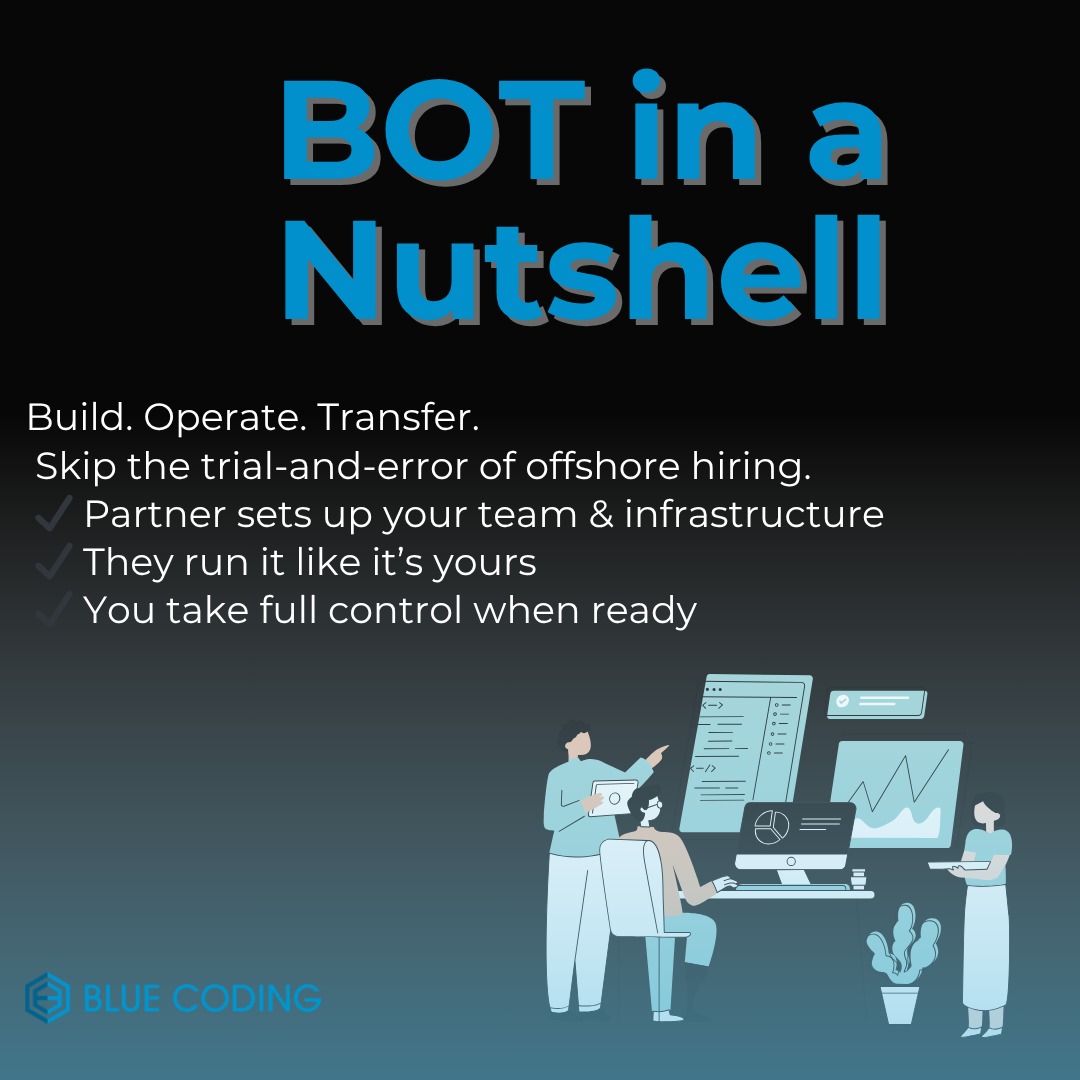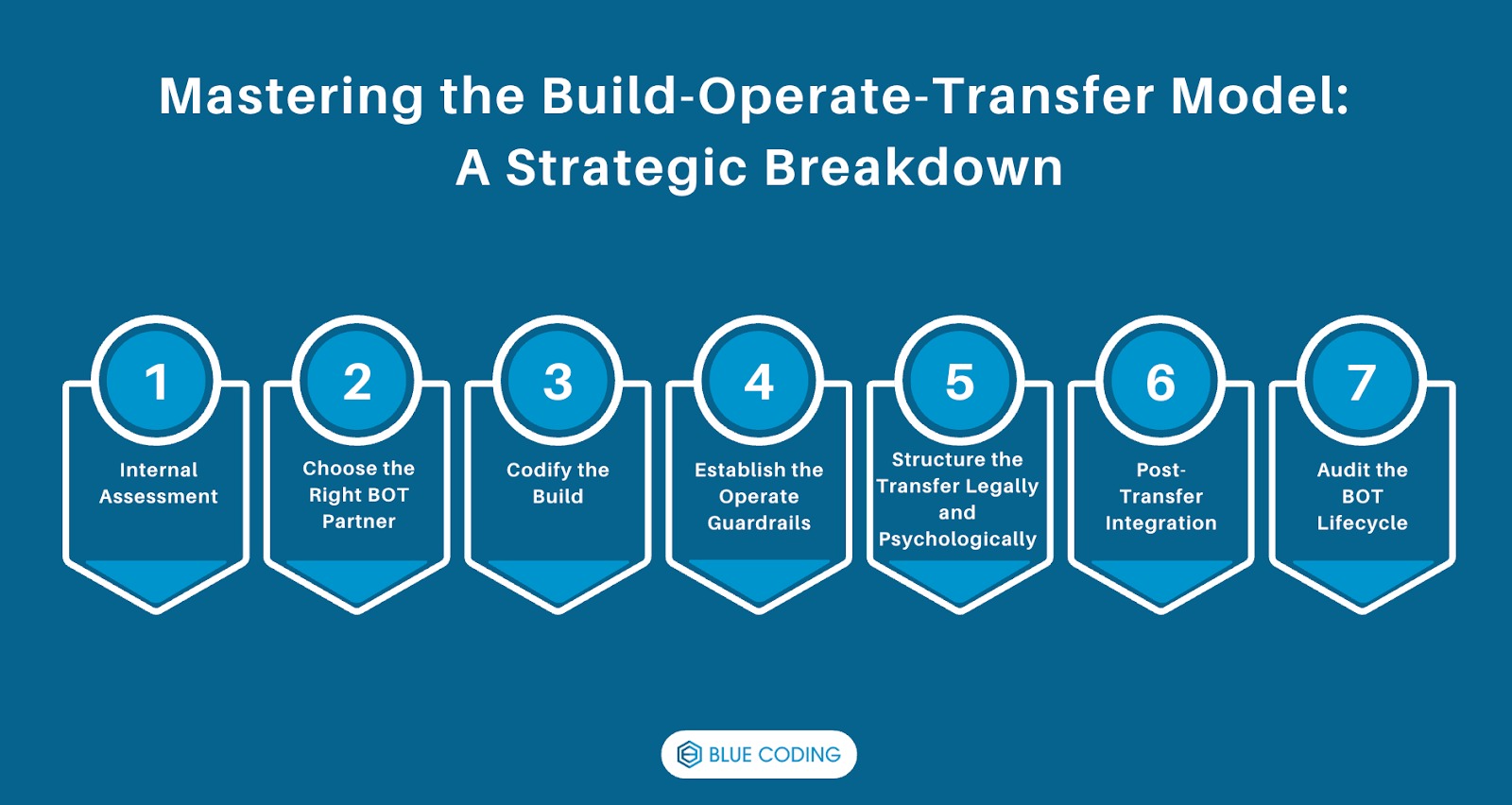 News
News
Most companies approach offshore hiring with two extremes: either fully outsourcing to a vendor or building their own remote entity from scratch. The Build Operate Transfer (BOT) model sits in the middle, but it is not just a compromise; it is a controlled acceleration strategy. BOT lets you launch a high-functioning, market-ready development team in another country without shouldering the upfront infrastructure or legal complexity. Your Build Operate Transfer in IT partner builds it, runs it like it is yours, aligns it to your delivery and culture standards, then hands it over when the timing is right. The result is that you skip the chaotic trial and error phase yet still end up with a fully integrated team under your direct ownership. In this guide, we are dissecting the BOT lifecycle in detail because when done right, the BOT model does not just hire developers for you, it engineers a turnkey extension of your company.
What Exactly Is Build-Operate-Transfer?
Let's discuss it in a bit more detail! Build-Operate-Transfer is not a vendor engagement model, but it is an infrastructure strategy disguised as outsourcing. At its core, a BOT model is a phased approach to establishing a fully functional, remote development or operations team in a foreign location without having to own the setup from day one. In the Build phase, your BOT partner recruits talent, sets up legal and technical infrastructure, and mirrors your internal standards to launch a dedicated offshore team. In the Operate phase, they fully manage that team, such as handling delivery, HR, compliance, and workflow, while gradually aligning the team’s rhythms with your HQ. Finally, during the Transfer phase, ownership of the entire operation, including team contracts, IP, processes, and sometimes even the office lease, is transitioned to you. It’s like acquiring a pre-vetted, pre-trained, and production-ready satellite team that already runs like part of your organization before you even put your name on the door.
Why More Companies Are Turning to Hire Developers With BOT Instead of Traditional Outsourcing
The shift toward the Build Operate Transfer in IT is a direct response to the operational gaps traditional outsourcing continues to expose. Businesses no longer want to throw work over the fence to third-party vendors and pray for delivery. They want long-term control, internal ownership, and real alignment with their core culture. BOT offers exactly that. It de-risks market entry, allows companies to test and validate global talent hubs under a managed setup, and then absorb those teams once they’ve proven their value. It’s about strategic scalability without losing technical authority. In a world where IP control, hiring speed, and global presence are competitive edges, BOT hands you all three without making you start from zero.

Mastering the Build-Operate-Transfer Model: A Strategic Breakdown for Hiring Developers Without Losing Control

Step 1: Internal Assessment
Before you even approach a BOT partner, you must conduct a deep internal audit of your operational gaps. This isn’t about listing tech stacks or desired developer headcounts. It’s about identifying your blind spots in local compliance, HR structures, infrastructure provisioning, and engineering bandwidth. Are you equipped to handle onboarding flows across borders? Do you have legal teams ready for regional contracts? If not, that becomes part of the BOT design. This step informs everything else, including timelines, costs, and your ownership expectations. Skip this, and you’re setting yourself up for future operational misfires.
Step 2: Choose the Right BOT Partner
Don’t get distracted by flashy branding or pitch calls with executives. Your BOT partner isn’t just executing a process. They’re temporarily co-owning a core piece of your engineering operations. You need someone who has completed full BOT cycles, not just built offshore teams. Can they actually transfer IP without leakage? Can they retain talent post-handoff? Have they established entities in tricky regions without hidden liability? Push for proof through detailed case studies and direct client references. A good BOT partner disappears at the right time. A bad one clings to control and ruins the transfer stage entirely.
Step 3: Codify the Build
This is where theoretical demand becomes technical architecture. You don’t just say you want React developers. You specify that you need React developers experienced in multi-region SSR, tested under load balancing, and integrated with a specific CI pipeline. You don’t request DevOps support. You document exactly how much of your GitOps, Kubernetes, and logging stack they’ll own. Get surgical about roles, seniority levels, delivery timelines, and communication overlaps with your HQ team. This isn’t headcount planning. This is a system design with human capital as the components.
Step 4: Establish the Operate Guardrails
This is where most BOT projects stall and stagnate. The Operate phase isn’t just about “managing” the team. It’s a co-ownership structure. You must define boundaries across five critical dimensions: delivery, people management, infrastructure, compliance, and culture. Who runs sprint reviews? Who signs off on PIPs or promotions? How does the team escalate blockers? Which tools are mandatory? What happens if local holidays disrupt velocity? Everything must be codified. The goal is to simulate your internal workflows while the vendor still technically owns the operation. If your own team wouldn’t recognize the offshore team’s way of working, you’ve already lost.
Step 5: Structure the Transfer Legally and Psychologically
The final handover isn’t a task. It’s a transition. Legally, it must involve airtight IP transfer agreements, staff employment conversion, and infrastructure ownership. But that’s only the mechanical part. The bigger risk is morale collapse. If the team feels abandoned by the vendor and unwelcome by you, expect silent attrition. Build toward the transfer with proactive cultural immersion. Issue internal email addresses early. Include them in all-hands calls. Let them demo directly to your executives. Turn the transition into a moment of recognition. Make it feel earned. A seamless transfer isn’t handed over. It’s staged in phases with intention.
Step 6: Post-Transfer Integration
After opting for hiring with the BOT model and once the team is yours, all the safety nets vanish. Everything from payroll taxes to VPN access to health insurance is now your burden. And yet, the team still expects the same pace, benefits, and clarity they had before. This gap creates disillusionment fast. You need a stabilization framework that spans HR, engineering, finance, and even branding. Align pay scales with HQ bands. Sync performance reviews with your existing cadences. Introduce leadership bridges from your core team to theirs. And most importantly, continue investing in retention. Just because they now wear your badge doesn’t mean they feel part of your mission yet.
Step 7: Audit the BOT Lifecycle
BOT is not a one-off project. It’s a replicable model that sharpens with every cycle. After your first complete BOT journey, run a multi-perspective review. What went over budget? Which assumptions about local talent were flawed? Where did you under- or over-engineer process control? Did your HQ teams feel confident in the transition or blindsided? Document everything. Turn this into an internal playbook. If you plan to repeat the model in another region, you now have real data, not theory. A good BOT model compounds knowledge across geographies. A lazy one resets to zero each time.
Choosing the Right Partner for Your BOT Journey
Blue Coding has spent years perfecting the Build Operate Transfer process for companies that demand precision, transparency, and long-term control. We do not just set up offshore teams; we design them to mirror your internal delivery rhythms, compliance standards, and cultural DNA from day one. By the time we hand over operations, you are absorbing a team that already thinks, works, and delivers like your own. If you are ready to launch a BOT initiative without gambling on the wrong partner, contact us today and let’s start building your next strategic advantage. We can discuss all the details and your queries on a free strategy call!



